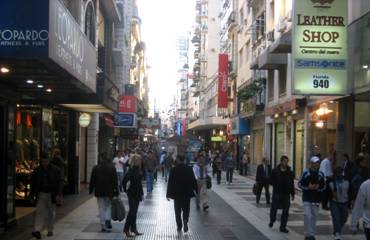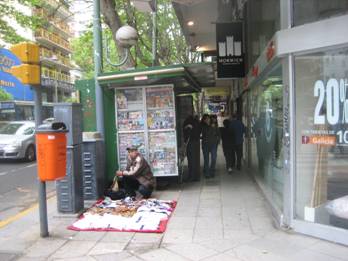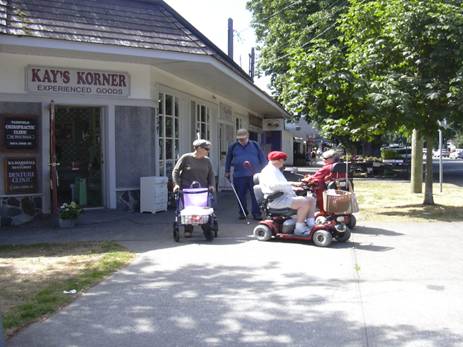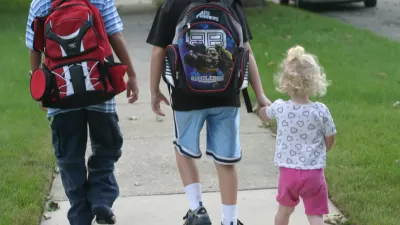I spent the last week teaching a professional development course for young planners in Buenos Aries, Argentina. It’s been a wonderful experience – my students are smart and enthusiastic, and Buenos Aries is a vibrant city with old-world charm. The buildings, plazas and old statues are beautiful and dignified, although a little frayed around the edges.
I spent the last week teaching a professional development course for young planners in Buenos Aries, Argentina. It's been a wonderful experience – my students are smart and enthusiastic, and Buenos Aries is a vibrant city with old-world charm. The buildings, plazas and old statues are beautiful and dignified, although a little frayed around the edges. While there I rode on the world's oldest operating subway carriages, some in service for more than a century, with lovely hardwood paneling and brass hardware like a vintage steamship. But for many people, visiting or residing in Buenos Aries would be a nightmare worse than anything you're likely to see this coming Halloween.
Buenos Aries residents are stylish – men wear classic suits and colorful silk ties, and women wear current but tasteful fashions. Yet, there is a disconnect between people's personal fastidiousness and the deterioration of the public realm. In particular, most of the city's sidewalks are in terrible shape, difficult enough for a healthy walker with practical shoes, but virtually impassable for people with disabilities.
 Pedestrianized streets such as Avenita Florida are filled with people.
Pedestrianized streets such as Avenita Florida are filled with people.
The few pedestrianized streets are jammed with walkers and vendors. But most streets are dominated by motor vehicle traffic with little accommodation for pedestrians. Most sidewalks are narrow, dirty, cracked, and blocked with countless potholes and encroachments such as parked motorcycles, vendors' stalls, utility poles and garbage. Buenos Aries presents countless barriers to people using mobility devices (the general term for wheelchairs and walkers). Many corners lack ramps, and many of the curbcuts that exist are carelessly designed and constructed. It's an absolute disaster!

Typical sidewalk conditions.

Vendors encroach on pedestrian space making sidewalks crowded and difficult to navigate for pedestrians.
During my stay I explored various parts of the city on foot. I must have passed many thousands of pedestrians. Yet, fewer than a dozen were using wheelchairs or walkers, and only one of those was traveling alone. Wheelchair users in Buenos Aries require assistance to maneuver around numerous cracks and potholes, and over curbs that lack adequate ramps.

Wheelchair users generally cannot travel without assistance.
What do these failures cost? A lot, in reduced productivity and lost dignity. People who lack basic mobility are unable to participate in activities that most of us take for granted: schooling, employment, shopping, recreation and socializing. Cities that fail to accommodate people with disabilities cannot attract a growing segment of tourists and residents – people with disabilities go elsewhere.
Public sidewalks are a critical component of the public realm, shared space where people naturally interact. Municipal governments have responsibility and control over these facilities – they determine their design, maintenance and management. Accommodating people with disabilities should be a top priority for transport planning.
I don't want to single out Buenos Aries, which is no worse than many other cities and better than some. At least the city has sidewalks with curb cuts, some subway stations have elevators, and some buses have wheelchair lifts. Many cities, particularly those in very poor countries, are much worse. But I could not help but be struck by the contrast between abundant private wealth - plenty of expensive clothes, luxury cars and new highways - and impoverished pedestrian infrastructure, and the cruelty this imposes on people who rely on these facilities for basic access.
In my home town of Victoria, British Columbia it is common see pedestrians with disabilities because we've made a reasonable effort to implement Universal Design (pedestrian environments designed to accommodate all possible users, including people with disabilities, baby strollers, hand carts and wheeled luggage). Our experience indicates that there is considerable latent travel demand by people with disabilities and other special needs – if we fail to accommodate them they are invisible. If we accommodate them they can participate in society.

The city of Victoria has good Universal Design and so attracts many people with disabilities as residents and tourists.
A common nightmare involves straining to reach an essential destination, but no matter how much you try it is always beyond reach, with each attempt thwarted by a new barrier, while everybody else passes by ignoring your difficulty. This nightmare is real for people with disabilities – without Universal Design it is simply impossible to reach many common destinations and activities, at least with dignity and affordability.
There is a relatively simple method for addressing this problem; establish minimum standards for pedestrian facilities that cover:
- Pedestrian connectivity (presence of sidewalks and paths across an area)
- Functional width (taking into account encroachments into the pedestrian way, including street furniture and vendors).
- Surface condition (cracks, potholes, tree roots, etc.)
- Cubcuts and ramps
- Street crossing conditions (presence of crosswalks and pedestrian signals, curb-to-curb distances, vehicle traffic speeds)
- Management and enforcement (for example, preventing encroachment, speeding cyclists and garbage in the pedestrian way).
Just as transportation planners produce maps which highlight roadways that have inadequate Level-of-Service ratings, planners can produce maps which show sidewalk and path conditions, highlighting those with significant problems. This information can be used to prioritize pedestrian improvements.
In most cities only a small percent of total transportation expenditures are devoted to pedestrian facilities, far smaller than total pedestrian mode split. (Conventional travel surveys generally indicate that only 5-10% of trips are by walking and cycling, but such surveys tend to undercount many nonmotorized trips, such as the walking links of transit trips, and local errands. In most cities, 10-20% of total trips are by walking and cycling, and sometimes even more.) For the cost of a single highway extension or rail line a city's total pedestrian facilities could typically be brought up to a level which accommodates all users, including people with disabilities.
Most of us are only "temporarily abled." At some point in our lives we or somebody we love will require Universal Design. Now is the best time to begin making a public realm that accommodates all possible users. Otherwise, we will live a nightmare of our own creation.

Trump Administration Could Effectively End Housing Voucher Program
Federal officials are eyeing major cuts to the Section 8 program that helps millions of low-income households pay rent.

Planetizen Federal Action Tracker
A weekly monitor of how Trump’s orders and actions are impacting planners and planning in America.

Ken Jennings Launches Transit Web Series
The Jeopardy champ wants you to ride public transit.

New Mexico Aging Department Commits to Helping Seniors Age ‘In Place’ and ‘Autonomously’ in New Draft Plan
As New Mexico’s population of seniors continues to grow, the state’s aging department is proposing expanded initiatives to help seniors maintain their autonomy while also supporting family caregivers.

USDOT Waters Down Self-Driving Car Regulations
The agency is reducing reporting requirements for autonomous vehicles and cars with self-driving features, prompting concern among safety advocates who say transparency is essential to the safe deployment of AV technology.

‘Minnesota Nice’ Isn’t so Nice When You Can’t Find a Place to Live
The Economic Development and Housing Challenge Program can help address the scourge of homelessness among Indigenous people.
Urban Design for Planners 1: Software Tools
This six-course series explores essential urban design concepts using open source software and equips planners with the tools they need to participate fully in the urban design process.
Planning for Universal Design
Learn the tools for implementing Universal Design in planning regulations.
Heyer Gruel & Associates PA
Ada County Highway District
Institute for Housing and Urban Development Studies (IHS)
City of Grandview
Harvard GSD Executive Education
Toledo-Lucas County Plan Commissions
Salt Lake City
NYU Wagner Graduate School of Public Service





























